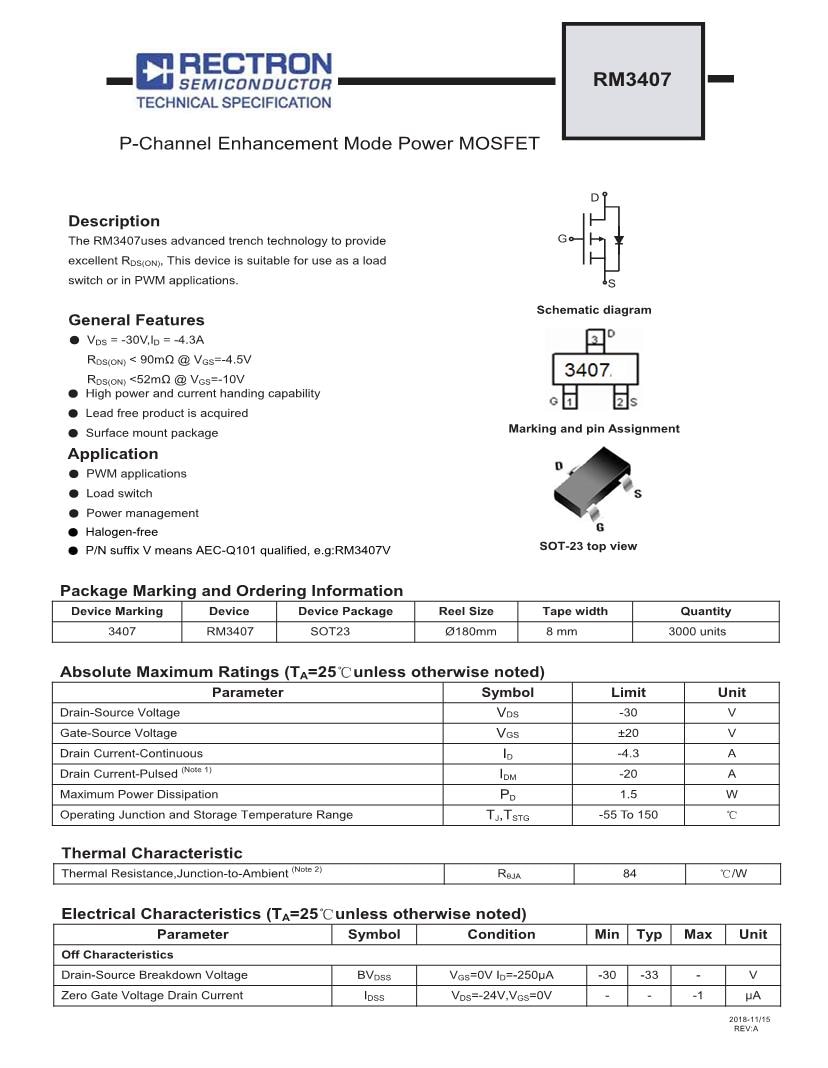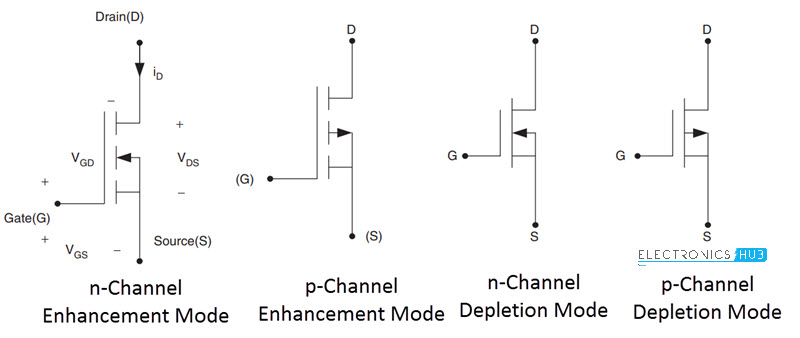A P-Channel MOSFET is a type of MOSFET in which the channel of the MOSFET is composed of a majority of holes as current carriers. When the MOSFET is activated and is on, the majority of the current flowing are holes moving through the channels.
In P-channel D-MOSFET, The source, drain, and channel is made up of P-type material upon an N-type substrate. P-channel has holes as the charge carrier. Therefore, to reduce the channel width or to attract electrons from the N-substrate, P-channel MOSFET is applied with positive gate voltage V GS. To turn on a P-Channel Enhancement-type MOSFET, apply a positive voltage VS to the source of the MOSFET and apply a negative voltage to the gate terminal of the MOSFET (the gate must be sufficiently more negative than the threshold voltage across the drain-source region (VG DS). This will allow a current to flow through the source-drain channel. P-Channel Enhancement MOSFET are available at Mouser Electronics. Mouser offers inventory, pricing, & datasheets for P-Channel Enhancement MOSFET. 31A, 60V, N-Channel Power MOSFET - Enhancement Type (AA Enabled) 2N6763: 31A, 60V, N-Channel Power MOSFET - Enhancement Type.
This is in contrast to the other type of MOSFET, which are N-Channel MOSFETs, in which the majority ofcurrent carriers are electrons.
Before, we go over the construction of P-Channel MOSFETs, we must go over the 2 types that exist. There are 2 types of P-Channel MOSFETs, enhancement-type MOSFETs and depletion-type MOSFETs.
A depletion-type MOSFET is normally on (maximum current flows from source to drain) when no differencein voltage exists between the gate and source terminals. However, if a voltage is applied to its gate lead, the drain-source channel becomes more resistive, until the gate voltage is so high, the transistor completely shuts off. An enhancement-type MOSFET is the opposite. It is normally off when the gate-source voltage is 0V(VGS=0). However, if a voltage is applied to its gate lead, the drain-source channel becomesless resistive.
In this article, we will go over how both P-Channel enhancement-type and depletion-type MOSFETs are constructed and operate.
How P-Channel MOSFETs Are Constructed Internally
An P-Channel MOSFET is made up of a P channel, which is a channel composed of a majority of hole current carriers. The gate terminals are made up of N-type material.
Depending on the voltage quantity and type (negative or positive)determines how the transistor operates and whether it turns on or off.
How a P-Channel Enhancement-type MOSFET Works
How to Turn on a P-Channel Enhancement Type MOSFET
To turn on a P-Channel Enhancement-type MOSFET, apply a positive voltage VS to the source of the MOSFET and apply a negative voltage to the gate terminal of the MOSFET (the gate must be sufficiently more negative than the threshold voltage across the drain-source region(VG
So with a sufficient positive voltage, VS, to the source and load, and sufficient negative voltage applied to the gate, the P-Channel Enhancement-type MOSFET is fully functional and is in the active 'ON' mode of operation.
How to Turn Off a P-Channel Enhancement Type MOSFET

To turn off a P-channel enhancement type MOSFET, there are 2 steps you can take. You can either cut off the bias positive voltage, VS, that powers the source. Or you can turn off the negative voltagegoing to the gate of the transistor.


How a P-Channel Depletion-type MOSFET Works
How to Turn on a P-Channel Depletion Type MOSFET
To turn on a P-Channel Depletion-Type MOSFET, for maximum operation, the gate voltage feeding the gate terminal should be 0V. With the gate voltage being 0V, the drain current is at is largest value and the transistor is in the active 'ON'region of conduction.
So, again, to turn on a P channel depletion-type MOSFET, positive voltage is applied to the source of the p-channel MOSFET. So we power the source terminal of the MOSFET with VS, a positive voltage supply. With a sufficient positive voltage, VS, and no voltage (0V) applied to the base, the P-channel Depletion-type MOSFET is in maximum operation and has the largest current.

How to Turn Off a P-Channel Depletion Type MOSFET
To turn off a P-channel MOSFET, there are 2 steps you can take. You can either cut off the bias positivevoltage, VDD, that powers the drain. Or you can apply a negative voltage to the gate. When a negativevoltage is applied to the gate, the current is reduced. As the gate voltage, VG, becomes more negative, the current lessens until cutoff, which is when then MOSFET is in the 'OFF' condition. This stops a large source-drain current.
So ,again, as negative voltage is applied to the gate terminal of the P channel depletion-type MOSFET, the MOSFET conducts less and less current across the source-drain terminal. When the gate voltage reaches a certain negative voltage threshold, it shuts the transistor off. Negative voltage shuts the transistor off. This is for a depletion-type P-channel MOSFET.
MOSFET transistors are used for both switching and amplifying applications. MOSFETs are perhaps the most popular transistors used today. Their high input impedance makes them draw very little input current, they are easy to make, can be made very small, and consume very little power.
Related Resources
How to Build a P-Channel MOSFET Switch Circuit
N-Channel MOSFET Basics
N Channel JFET Basics
P Channel JFET Basics
Types of Transistors
In field-effect transistors (FETS), depletion mode and enhancement mode are two major transistor types, corresponding to whether the transistor is in an ON state or an OFF state at zero gate-source voltage.
Enhancement-mode MOSFETS (metal–oxide–semiconductor FETs) are the common switching elements in most integrated circuits. These devices are off at zero gate–source voltage. NMOS can be turned on by pulling the gate voltage higher than the source voltage, PMOS can be turned on by pulling the gate voltage lower than the source voltage. In most circuits, this means pulling an enhancement-mode MOSFET's gate voltage towards its drain voltage turns it ON.
In a depletion-mode MOSFET, the device is normally ON at zero gate–source voltage. Such devices are used as load 'resistors' in logic circuits (in depletion-load NMOS logic, for example). For N-type depletion-load devices, the threshold voltage might be about –3 V, so it could be turned off by pulling the gate 3 V negative (the drain, by comparison, is more positive than the source in NMOS). In PMOS, the polarities are reversed.
The mode can be determined by the sign of the threshold voltage (gate voltage relative to source voltage at the point where an inversion layer just forms in the channel): for an N-type FET, enhancement-mode devices have positive thresholds, and depletion-mode devices have negative thresholds; for a P-type FET, enhancement-mode negative, depletion-mode positive.
| NMOS | PMOS | |
|---|---|---|
| Enhancement-mode | Vd > Vs (typ) ON: Vg ≥ Vs + 3V OFF: Vg ≤ Vs | Vd < Vs (typ) ON: Vg ≤ Vs - 3V OFF: Vg ≥ Vs |
| Depletion-mode | Vd > Vs (typ) ON: Vg ≥ Vs OFF: Vg ≤ Vs - 3V | Vd < Vs (typ) ON: Vg ≤ Vs OFF: Vg ≥ Vs + 3V |
Junction field effect - transistors (JFETs) are depletion mode, since the gate junction would forward bias if the gate were taken more than a little from source toward drain voltage. Such devices are used in gallium arsenide and germanium chips, where it is difficult to make an oxide insulator.
Alternative terminology[edit]
Some sources say 'depletion type' and 'enhancement type' for the device types as described in this article as 'depletion mode' and 'enhancement mode', and apply the 'mode' terms for which direction the gate–source voltage differs from zero.[1] Moving the gate voltage toward the drain voltage 'enhances' the conduction in the channel, so this defines the enhancement mode of operation, while moving the gate away from the drain depletes the channel, so this defines depletion mode.
Enhancement-load and depletion-load logic families[edit]
Depletion-load NMOS logic refers to the logic family that became dominant in silicon VLSI in the latter half of the 1970s; the process supported both enhancement-mode and depletion-mode transistors, and typical logic circuits used enhancement-mode devices as pull-down switches and depletion-mode devices as loads, or pull-ups. Logic families built in older processes that did not support depletion-mode transistors were retrospectively referred to as enhancement-load logic, or as saturated-load logic, since the enhancement-mode transistors were typically connected with gate to the VDD supply and operated in the saturation region (sometimes the gates are biased to a higher VGG voltage and operated in the linear region, for a better power–delay product (PDP), but the loads then take more area).[2] Alternatively, rather than static logic gates, dynamic logic such as four-phase logic was sometimes used in processes that did not have depletion-mode transistors available.
For example, the 1971 Intel 4004 used enhancement-load silicon-gate PMOS logic, and the 1976 Zilog Z80 used depletion-load silicon-gate NMOS.
History[edit]
The first MOSFET (metal-oxide-semiconductor field-effect transistor) demonstrated by Egyptian engineer Mohamed M. Atalla and Korean engineer Dawon Kahng at Bell Labs in 1960 was an enhancement mode siliconsemiconductor device.[3] In 1963, both depletion and enhancement mode MOSFETs were described by Steve R. Hofstein and Fred P. Heiman at RCA Laboratories.[4] In 1966, T.P. Brody and H.E. Kunig at Westinghouse Electric fabricated enhancement and depletion mode indium arsenide (InAs) MOS thin-film transistors (TFTs).[5][6]
P Type Mosfet Circuits

References[edit]
- ^John J. Adams (2001). Mastering Electronics Workbench. McGraw-Hill Professional. p. 192. ISBN978-0-07-134483-8.
- ^Jerry C. Whitaker (2005). Microelectronics (2nd ed.). CRC Press. p. 6-7–6-10. ISBN978-0-8493-3391-0.
- ^Sah, Chih-Tang (October 1988). 'Evolution of the MOS transistor-from conception to VLSI'(PDF). Proceedings of the IEEE. 76 (10): 1280–1326 (1293). doi:10.1109/5.16328. ISSN0018-9219.
- ^Hofstein, Steve R.; Heiman, Fred P. (September 1963). 'The silicon insulated-gate field-effect transistor'. Proceedings of the IEEE. 51 (9): 1190–1202. doi:10.1109/PROC.1963.2488.
- ^Woodall, Jerry M. (2010). Fundamentals of III-V Semiconductor MOSFETs. Springer Science & Business Media. pp. 2–3. ISBN9781441915474.
- ^Brody, T. P.; Kunig, H. E. (October 1966). 'A HIGH‐GAIN InAs THIN‐FILM TRANSISTOR'. Applied Physics Letters. 9 (7): 259–260. doi:10.1063/1.1754740. ISSN0003-6951.
P Channel Enhancement Mosfet Operation
